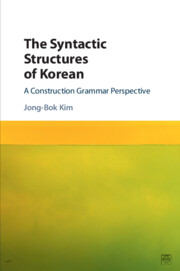Book contents
- Frontmatter
- Contents
- Acknowledgments
- Abbreviations
- 1 Theoretical foundations
- 2 Noun phrases
- 3 Case system
- 4 Auxiliary and complex predicate constructions
- 5 Gerund phrases and mixed categories
- 6 Verbal nouns and light verb constructions
- 7 Serial verb constructions
- 8 Negation and related phenomena
- 9 Coordination
- 10 Passive constructions
- 11 Wh-questions
- 12 Topic and focus constructions
- 13 Relative clause constructions
- 14 Honorification
- References
- Index
13 - Relative clause constructions
Published online by Cambridge University Press: 05 July 2016
- Frontmatter
- Contents
- Acknowledgments
- Abbreviations
- 1 Theoretical foundations
- 2 Noun phrases
- 3 Case system
- 4 Auxiliary and complex predicate constructions
- 5 Gerund phrases and mixed categories
- 6 Verbal nouns and light verb constructions
- 7 Serial verb constructions
- 8 Negation and related phenomena
- 9 Coordination
- 10 Passive constructions
- 11 Wh-questions
- 12 Topic and focus constructions
- 13 Relative clause constructions
- 14 Honorification
- References
- Index
Summary
Relative clause constructions in Korean have been notorious for their complexity in terms of syntax and semantics. This chapter develops a construction-based HPSG analysis of Korean relatives. The analysis is “headdriven” and “constraint-based” in the sense that the head of a relative clause and the declarative constraints on well-defined constructions play a crucial role in the formation of relative clauses. The analysis enables us to eliminate invisible elements (i.e., trace or empty operator) in licensing Korean relative clauses and further allows us to express cross-cutting generalizations among different types of relatives.
Some key properties
The Korean relative clause constructions are often characterized by flexible application of the relative morphology, lack of relative pronouns and omission of arguments (see, among others, Na and Huck 1993, Kim 1998b, 2004, Han and Kim 2001, Chae 2012). These properties contribute to the overall structural complexity of the relative clause constructions in Korean. Consider the following two typical relative clause constructions:
(1) a. [mek-nun] mwul
eat-MOD water
‘water that one drinks’
b. [Kim-i mek-un] ceskalak
Kim-NOM eat-MOD chopsticks
These examples illustrate that the interpretation of relative clauses is in part dependent upon world knowledge or contexts. The natural reading of (1a) is the one in which the direct object is relativized with the subject being unexpressed. It would be difficult to interpret this as a subject relativization since “water” cannot eat/drink anything. The relative clause (1b) could be ambiguous: the most natural reading is “the chopsticks that Kim ate with.” In an imaginary context (where chopsticks are made from edible materials), one may have a reading like “the chopsticks that Kim ate,” where the direct object is relativized.
Further complications relating to Korean relative clause constructions also could be found from examples like (2) (Na and Huck 1993, Han and Kim 2001):
(2) a. [NP[S[_i_ j tha-ko tani-nun] cha j -ka] mesci-n]
ride-CONN drive-Mod car-Nom stylish-Mod
sinsai
gentleman
(lit.) ‘gentlemani who the car j that [hei] is driving is stylish’
b. [NP [S [_i_ j kac-ko iss-nun] khemphyuthej-ka]
MAC-i-n] kyoswui
MAC-COP-MOD professor
(lit.) ‘professori who the computer j that [hei] has is a MAC’
In (2), the relative heads sinsa ‘gentleman’ and kyoswu ‘professor’ have been relativized out of the more deeply embedded relative clause, violating the CNPC (Complex Noun Phrase Constraint).
- Type
- Chapter
- Information
- The Syntactic Structures of KoreanA Construction Grammar Perspective, pp. 283 - 317Publisher: Cambridge University PressPrint publication year: 2016

